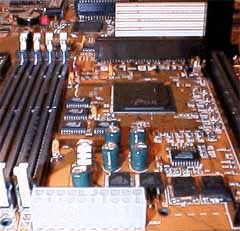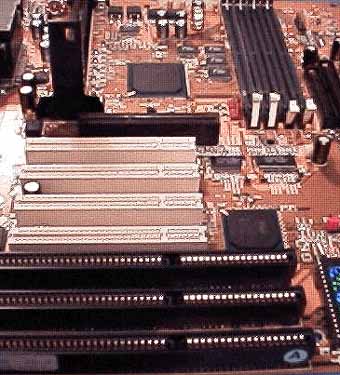ABIT LX6 LX Pentium II Board
by Anand Lal Shimpi on November 30, 1997 8:08 AM EST- Posted in
- Motherboards
|
Since the LX6 was first announced quite a few pre-release versions emerged, although they were mostly confined to hardware testers and magazine editors they did find their way into the mainstream market. What to look out for when shopping for a LX6? The motherboard revision number should be NO LESS THAN 1.0, and the BIOS should be dated around 11/03/97 and it shouldn't be an "Evaluation ROM". As long as your LX6 meets those preceding requirements we'll be looking at the same motherboard, however if your LX6 doesn't meet any one of the above stipulations don't expect it to be anything like the final revision LX6 reviewed here. If your vendor happened to ship you a pre-release LX6 demand a RMA, do not settle with the motherboard you have since it most likely has quite a few problems that a simple exchange could fix. |
| Socket Style: | Slot-1 |
| Chipset: | i82440LX |
| Cache: | N/A (On Chip) |
| Form Factor: | ATX |
| BUS Speeds: | 60 / 66 / 68 / 75 / 83 / 100 MHz |
| Clock Multipliers: | 2.0x / 2.5x / 3.5x / 4.0x / 4.5x / 5.0x |
| Voltages Supported: | 1.5v - 3.5v (Auto Detect) |
| RAM Slots: | 4 168pin DIMM Slots (EDO/SDRAM) |
| AGP/PCI/ISA Slots: | 1 AGP Slot 4 PCI Slots 3 ISA Slots (1 Shared / 3 Full Length) |
| BIOS: | AWARD PnP BIOS w/
SoftMenuTM Jumperless CPU Configuration |
| PCI EIDE Controller: | Super I/O 2 EIDE Channels 1 FDD Channel 2 Serial /1 EPP |
 |
Start from the bottom and build up. That was ABIT's philosophy when they designed the IT5H and it is evident that it was the same philosophy used when the LX6 was designed. One of the most important things to realize as an engineer is that you cannot slack off in one area of your design in order to compensate for excelling in another area. Most LX boards that have been released feature a ridiculous 3 SDRAM DIMM slots instead of a full set of 4 DIMM slots to make expansion a bit easier. ABIT on the other hand, started with the basic requirements for an excellent motherboard, 4 DIMM slots, 3 ISA slots, 4 PCI, 1 AGP, and moved on from there. |
| Due to the inclusion of an AGP slot in all LX motherboard designs we must realistically limit ourselves to 3 ISA & 4 PCI slots or vise versa (2 ISA slots is simply out of the question at this point in time). Since most newer peripherals are PCI based, it would make sense to include more PCI than ISA slots while remembering not to sacrifice expandability to compensate for any other aspect of the motherboard itself. The LX6 also features a total of 5 external fan connectors for added cooling...wonder why ABIT decided to include so very many connectors? Keep on reading to find out what the LX6 offers that has the critics, including myself, begging for more cooling... | |
Like all newer ABIT motherboards, the LX6's user manual can sometimes referred to as a crash course in engineering due to its incredible attention to detail. This has come to be expected from ABIT in all of their motherboards and their excellent writing style used in the included written documentation of the LX6 (as well as other ABIT motherboards) makes the initial setup and configuration your new purchase a pleasing one. The only part of the ABIT manual which is lacking detail, as is nearly every other motherboard manual in the world, is a description of the Chipset Features of the BIOS Setup Utility, information that is critical to getting the most performance out of your system.
| The LX6's layout conforms fully to the ATX specification, which makes installing the LX6 in your ATX case a breeze. Like most newer ABIT motherboards, the LX6 features the popular SoftMenuTM Jumperless CPU Setup utility which integrates nicely into the commonly known AWARD BIOS Configuration package. The SoftMenuTM Utility allows the user to select the CPU clock speed from a number of internally preset options, or the user can simply specify the bus speed/clock multiplier manually, this feature found in most newer LX motherboards under different names of course makes overclocking the LX6 almost second nature. |  |
| The LX6 features a fully operational menu containing the selectable 60, 66, 68, 75, 83, and 100MHz bus speeds in the SoftMenuTM Setup utility. The most highly anticipated feature of any motherboard to date has been the inclusion of a 100MHz bus speed setting, and unexpectedly ABIT has provided us with this setting that has been passed around as a mere rumor for quite some time. Originally designed for Internal Testing *ONLY* the ABIT LX6's 100MHz bus speed setting was never intended to make it to the mainstream market as a functional option, however when the pre-release boards made it into the hands of testers we began to speculate as to why the setting was even included in the SoftMenuTM setup if it wasn't going to be used for any purpose. The internal testing of the LX6 at the 100MHz bus speed was supposed to be conducted on a special version of the Pentium II and left alone never to be used again. However when the thought of running current Pentium II processors at the 100MHz bus speed ABIT's eyes lit up...as did the eyes of thousands of overclockers all around the world. Could ABIT redeem themselves after the horror stories of the pre-release LX6 made their way into the public's ears by simply enabling this 100MHz bus speed? | |











0 Comments
View All Comments